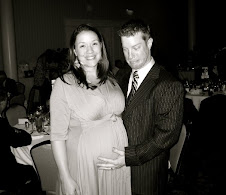I've been having Braxton Hicks (a.k.a. False Labor) contractions for the last 3 weeks. Each week they seem to get stronger. I've heard Braxton Hicks Contractions described as "an annoying tight feeling" by several books and our teacher at the labor and delivery class. Mine ARE annoying but because they're getting stronger they're borderline painful.
Several people have asked me what are Braxton Hicks contractions? What's the difference between these and regular contractions? Etc. I figured I'd post an article about them and inject a little about what I'm expiriencing throughout. I found this article to be better than any of the others I've read.
Katie T. -- this article is a must read for you!
My comments in blue.
True vs. False Labor
by Lisa Rodriguez, R.N. and Marjorie Greenfield, M.D.
reviewed by Marjorie Greenfield, M.D.
"How will I know when it is REAL labor?" is a question many first-time moms have as they approach the end of the pregnancy. The mothers-to-be worry that the contractions may stop when they arrive at the hospital and they will be sent home. Conversely, many also worry that they will deliver at home or in the car on the way to the hospital if they wait too long.
What are Braxton-Hicks Contractions?
During the third trimester, your uterus begins to contract. It normally feels like a tightening or a low menstrual-like cramp. It may feel as if the baby is "balling up". Exactly! This, of course, is not the baby, but is your uterus generating that sensation. These early contractions are called Braxton-Hicks contractions, named after the obstetrician who first described them. Even Braxton-Hicks contractions can sometimes be painful. Per my earlier comments. This can be the confusing part about when to pay attention to them. Contractions in false labor may even come at regular 5-minute intervals, lasting about 30 seconds. Mine are almost exactly this -- 3-5 min apart lasting no more than 30-45 seconds. This may go on for hours. Even women who have had already had children go to the hospital thinking they are in real labor and find out is was a false alarm.
Here are a few guidelines when distinguishing true from false labor:
Timing of Contractions
• False Labor: Often irregular; not usually becoming closer together
• True Labor: Come regularly, usually 4-6 minutes apart and can become closer together. Usually last 30-70 seconds.
Strength of Contractions
• False Labor: Frequently weak; not getting stronger with time, or alternately, a strong contraction followed by weaker ones.
• True Labor: Become stronger with time. You may also feel vaginal pressure
Pain with Contractions
• False Labor: Usually felt in the front only.
• True Labor: Can start in the back and move to the front. I have felt front/back in my false labor.
Position Changes and Hydration
• False Labor: Contractions may stop or slow down when you walk, lie down, change position or increase your fluid intake. This usually works! Only one night I switched from walking to laying down and they stuck around for a while but I eventually fell asleep so they must have gone away!
• True Labor: Contractions continue no matter what position changes you make or how much you drink.
Should I Stay or Should I Go?
If you are less than 35 weeks pregnant and you have regular contractions lasting more than thirty seconds and occurring more than 4-6 times an hour, try resting and drinking lots of fluids. If the contractions don't settle down with these changes in activity, call your practitioner. The signs of preterm labor can be subtle, and should be evaluated.
Once you are past 36 weeks, if this is a first pregnancy, you are much more likely to go in to your birth place too early rather than too late. Don't time contractions until they are very strong and regular. Plan to go to the hospital when they are so strong that you cannot hold a conversation during one, This is my new rule of thumb! Love it! closer than 5 minutes apart, and continue in that pattern for over an hour. For women who have given birth before, we recommend using your previous labor as a guideline. On average, second babies come in half the time it took for the first. Subsequent pregnancies are usually similar to the second one.
If you just aren't sure whether it is false or real labor, don't feel bad going into labor and delivery to be examined. Your practitioner and the nurses there see many women each day in false labor. Sometimes it is even hard for the professionals to distinguish if it is the real thing.
Friday, July 10, 2009
Subscribe to:
Post Comments (Atom)




2 comments:
I am so happy that our article spoke to you! And I love your comments sprinkled through! From Marge Greenfield MD www.marjoriegreenfield.com
Wonderful article. Thank you for posting this :)
Post a Comment